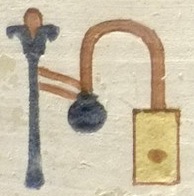



This page displays details of the selected Monument. Click on the Monument number to list all individual signs ("occurrences") recorded from that object or structure.
Monument : Karnak Room XII
Period : Dynasty XVIII
Reign(s) : Hatshepsut
High Date : 1473
Low Date : 1458
Monument type : Temple
Localisation or provenance : Karnak
References : PM II, 103 (Plan XI, Scene 302); Photos Nunn.
These samples are taken from Room XII, north of the Granite Sanctuary and east of the Sixth Pylon. They were chosen because of their fresh colours, well preserved despite the destruction of the images, names and titles of Hatshepsut by Thutmoside iconoclasts. Green in this inscription is a bright turquoise and blue a rather darker shade. The two can easily be distinguished by observing the sign O49 a village with crossroads which has a blue outer wall and triangles and a green cross. M17 a flowering reed is also green, seen clearly when compared to the blue sign X1 a loaf of bread. The background is painted in a pale grey-blue wash that contrasts well with the bright colours used for the hieroglyphs. This has allowed the scribe-painter to use a white fill as a symbol of transparency or emptiness. This can be seen, for example, in the sign D21 to indicate an open mouth. This kind of contrasting grey-blue background can also be seen in the KV.22 tomb of Amenhotep III (1390-1352) and especially in the KV.57 tomb of Horemheb (1323-1295) where it serves as a symbol of the darkness of the Duat : the region through which the god Rê passes during his night-time journey in the solar bark (Schweizer 2010, 34-36 et passim).